Digital Poster
Imaging & Biomarkers in Parkinson’s Disease
ISMRM & ISMRT Annual Meeting & Exhibition • 10-15 May 2025 • Honolulu, Hawai'i

 |
Computer Number: 113
4539. Data
Driven Subtyping Reveals Two Distinctive Patterns of Deep Gray
Matter atrophy and Dopamine Availability in early Parkinson’s
Disease
Y. Oh, G. Park, H. Kim
College of Medicine, The Catholic University of Korea, Seoul, Korea, Republic of
Impact: Two subtypes displayed distinctive patterns in
dopamine availability, deep gray matter volume, cognition,
motor symptom, and cardiac denervation, supporting the
body-first and brain-first concepts of PD through
imaging-machine learning approach.
|
|
 |
Computer Number: 114
4540. Assessing
abnormal oxygen extraction fraction (OEF) and neural tissue
susceptibility in Parkinson’s Disease
A. Misra, A. M. Oros-Peusquens, I. Dogan, K. Reetz, N. J.
Shah, J. Cho
State university of new York at buffalo, Buffalo, United States
Impact: This
study demonstrates QQ’s feasibility for detecting abnormal
oxygen metabolism and iron accumulation in PD. Using a
single routine MRI sequence, QQ is readily applicable for
investigating PD pathophysiology and other neurologic
disorders.
|
|
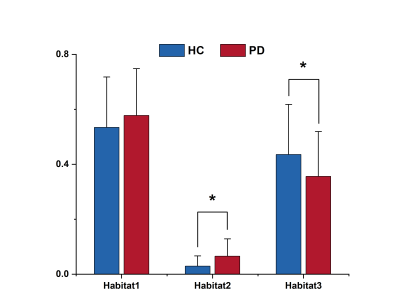 |
Computer Number: 115
4541. Implications
of habitat analysis for substantia nigra based on diffusion
kurtosis imaging in Parkinson's disease
N. Zhang, S. Shang, J. Shi, H. Zhang, J. Ye
Northern Jiangsu People’s Hospital, Yangzhou University, China, JiangSu, China
Impact: This study verified habitat analysis based on
DKI can subdivide the SN from the aspect of microstructure
to further analyze the heterogenetic pathology.
|
|
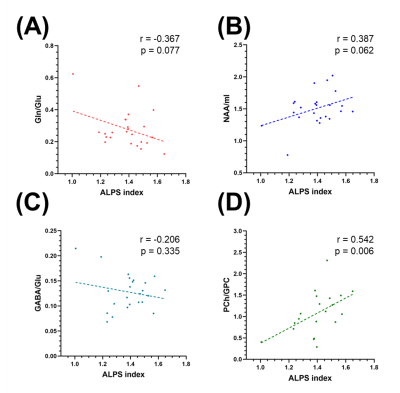 |
Computer Number: 116
4542. Association
between Brain Metabolite Changes and Glymphatic Dysfunction in
Parkinson’s Disease: A Combined MRS and DTI-ALPS Study
Y. J. Bae, J. M. Kim, H. B. Yoo, Y. Seo, H. H. Lee
Seoul National University Bundang Hospital, Seoul National University College of Medicine, Seongnam, Korea, Republic of
Impact: Our findings reveal that glymphatic dysfunction
in PD may underlie metabolic disruptions, potentially
serving as markers for neurodegenerative process. These
insights could open new avenues for metabolic and
glymphatic-based diagnostic and therapeutic strategies in
neurodegenerative diseases.
|
|
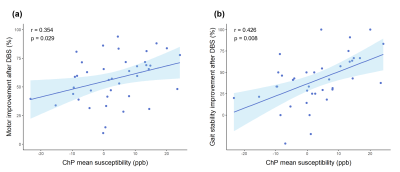 |
Computer Number: 117
4543. Correlation
Between Choroid Plexus Calcification and Motor Outcomes of Deep
Brain Stimulation in Parkinson’s Disease
S. Fang, G. Li, Y. Tang, C. Yang, L. Chen, C. Ma, X. Wu, J.
Li
Shanghai Key Laboratory of Magnetic Resonance, School of Physics and Electronic Science, East China Normal University, Shanghai, China
Impact: The extent of choroid plexus calcification
measured by quantitative susceptibility mapping is
negatively correlated with DBS outcomes, offering a
potential biomarker to optimize patient-specific DBS
prognosis.
|
|
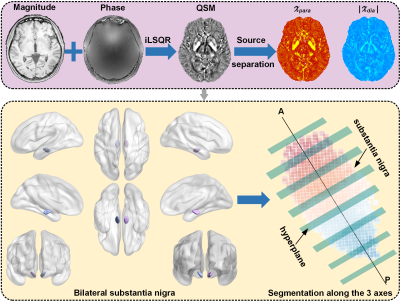 |
Computer Number: 118
4544. Microstructural
gradients of magnetic susceptibility in the substantia nigra in
Parkinson’s disease using QSM and spatial gradients analysis
W. Lu, B. Xu, J. Lu
Xuanwu Hospital Capital Medical University, Beijing, China
Impact: The application of QSM source separation and
spatial gradients analysis provides a novel insight for the
spatially varying magnetic susceptibility in the SN of PD
patients in vivo, which is conducive for understanding the
function of the SN in PD.
|
|
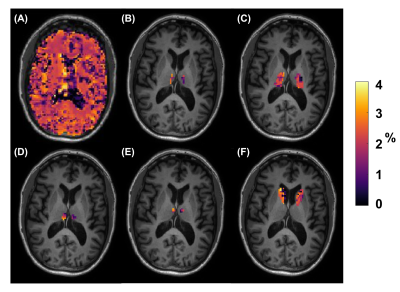 |
Computer Number: 119
4545. Guanidino
Chemical Exchange Saturation Transfer MRI (GuanCEST) signal
intensity reductions as a surrogate biomarker for Parkinson’s
Disease
K. Wang, N. Yadav, Z. Yang, P. van Zijl, K. Mills, J. Xu, J.
Prasuhn
Johns Hopkins University School of Medicine, Baltimore, United States
Impact: Reductions in Cr-weighted GuanCEST MRI signal in
several sensitive brain regions correlated to Parkinson’s
severity, based on motor system scores, suggesting a
potential biomarker to help identify responsive cohorts for
targeted treatments and trial design.
|
|
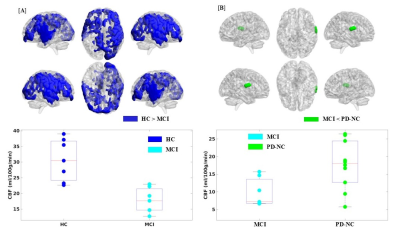 |
Computer Number: 120
4546. Multidelay
Pseudocontinous Arterial Spin Labeling MRI To Understand Mild
Cognitive Impairment in Individuals with Parkinson’s Disease
N. Chaurasiya, G. Rathi, A. Gerstenecker, D. Geldmacher, N.
Stover, V. Mishra
University of Alabama at Birmingham, Birmingham, United States
Impact: This study demonstrates the potential of ATT and
CBF as neuroimaging biomarkers for diagnosing mild cognitive
impairment (MCI) in Parkinson’s disease (PD). These findings
highlight the promise of ATT and CBF in enabling early and
accurate cognitive assessment of PD-MCI.
|
|
 |
Computer Number: 121
4547. Exploring
Cortical Myelination to Understand Freezing of Gait in
Parkinson’s Disease
G. N. Rathi, J. Longhurst, Z. Mari, V. R. Mishra
University of Alabama at Birmingham, Birmingham, United States
Impact: Cortical myelination reduction correlated with
clinical and PT scores, suggests CM as a useful biomarker in
settings needing detailed symptom tracking. CM could guide
interventions, preserving mobility and reducing fall risks
in severe PD-FoG cases.
|
|
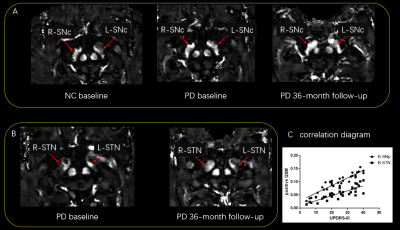 |
Computer Number: 122
4548. Separated
Source QSM Reveals Dynamic Iron Deposition in Parkinson's
Disease: A Longitudinal Study
Q. Zeng, B. Xu, L. Chen, L. Zeng, X. Luo, J. Li, N. Hong, G.
Cheng
Peking University Shenzhen Hospital, shenzhen, China
Impact: This study applies susceptibility source
separation method for quantifying paramagnetic iron
deposition in PD, offering insights into disease
progression. It enhances our understanding of iron
accumulation in specific brain regions, potentially guiding
future therapeutic strategies targeting iron dysregulation.
|
|
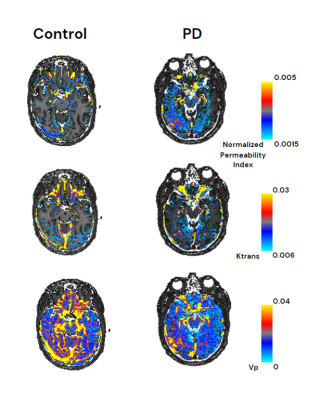 |
Computer Number: 123
4549. Impaired
Blood Brain Barrier in Parkinson’s Disease: A DCE-MRI study
S. Fajerzstein, G. Eshed, A. Thaler, A. Mirelman, T. Shiner,
N. Giladi, R. Alcalay, R. Orad, N. Bregman, S. Mirloo, L.
Kamintsky, M. Artzi, U. Nevo, D. Milikovsky, D. Ben Bashat
The Iby and Aladar Fleischman Faculty of Engineering TAU; Israel, Tel Aviv, Israel
Impact: This study demonstrates that DCE-MRI can detect
BBB dysfunction in PD, marked by higher permeability and
lower vascularity, offering insights for diagnostics,
biomarker discovery, and BBB-targeted treatment development
in Parkinson's disease.
|
|
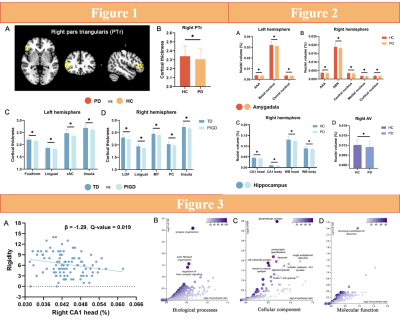 |
Computer Number: 124
4550. Ultra-high
field neuroimaging reveals disease-related reconfiguration in PD
and associations with cytoskeleton and synaptic function
X. Wang, Y. Xiong, X. Lou
Chinese PLA General Hospital, Beijing, China
Impact: Disease-related structural reconfiguration, the
novel concept introduced in this study, providing new
evidence for revealing the pathogenic mechanisms of
early-stage Parkinson’s disease and understanding the
specific genes that influence brain structure.
|
|
 |
Computer Number: 125
4551. Assessment
of white matter changes and grey matter atrophy in a 6-OHDA
Parkinson's model
M. Bergamino, A. Fuentes, I. Sandoval, D. Marmion, C.
Bishop, S. Zhu, F. Manfredsson, A. Stokes
Barrow Neurological Institute, Phoenix, United States
Impact: This study shows that free-water DTI and VBM are
effective tools for examining Parkinson’s disease-related
brain degeneration, providing insights into
neurodegenerative mechanisms such as neuroinflammation and
gray matter atrophy linked to PD progression.
|
|
 |
Computer Number: 126
4552. More
insights into disruption and decoupling of individually
metabolic connectomes in Parkinson’s disease
S. Shang, J. Shi, J. Ye
Northern Jiangsu People's Hospital Affiliated to Yangzhou University, Yangzhou, China
Impact: Our study revealed complex metabolic
disconnections underlying the neurodegenerative process in
PD, highlighting the clinical implications of multi-delay
ASL for comprehensive investigations of metabolic patterns
of disconnection syndromes.
|
|
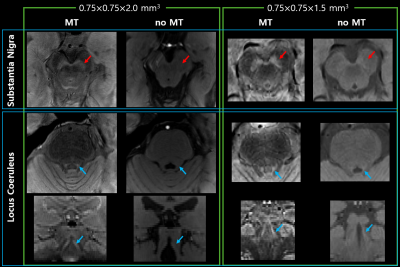 |
Computer Number: 127
4553. Fast
neuromelanin imaging using the EP-vfMT technique
S-H Oh, K. Sakaie, S. Jones, M. Lowe
Cleveland Clinic Foundation, Cleveland, United States
Impact: The speed of the proposed acquisition will
enable examination of EP-vfMT as an imaging biomarker for
early-stage neurodegeneration in Parkinson's disease,
Alzheimer's disease and other neurogenerative disorders.
|
|
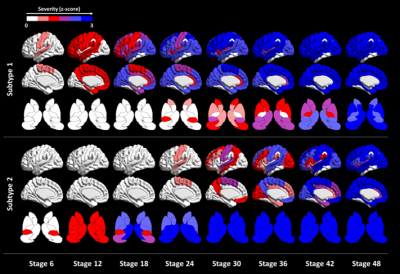 |
Computer Number: 128
4554. Data-Driven
MRI-Based Subtyping of Parkinson's Disease Reveals Cortex-First
and Deep Grey-First Progression Patterns
G. Park, J. Ha, J. Youn, H. Kim
Keck School of Medicine of University of Southern California, Los Angeles, United States
Impact: Identifying PD subtypes with distinct
neurodegeneration patterns enhances understanding of disease
heterogeneity, potentially guiding personalized therapeutic
strategies and improving prognostic predictions for patients
with PD.
|
The International Society for Magnetic Resonance in Medicine is accredited by the Accreditation Council for Continuing Medical Education to provide continuing medical education for physicians.